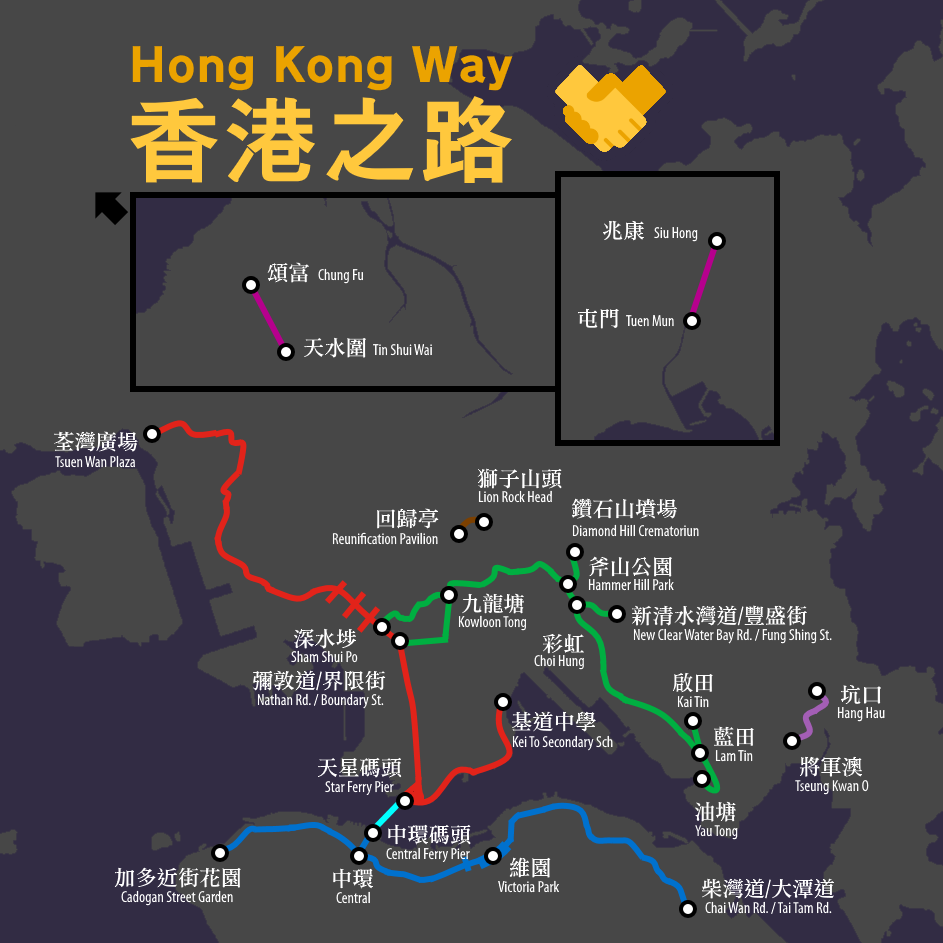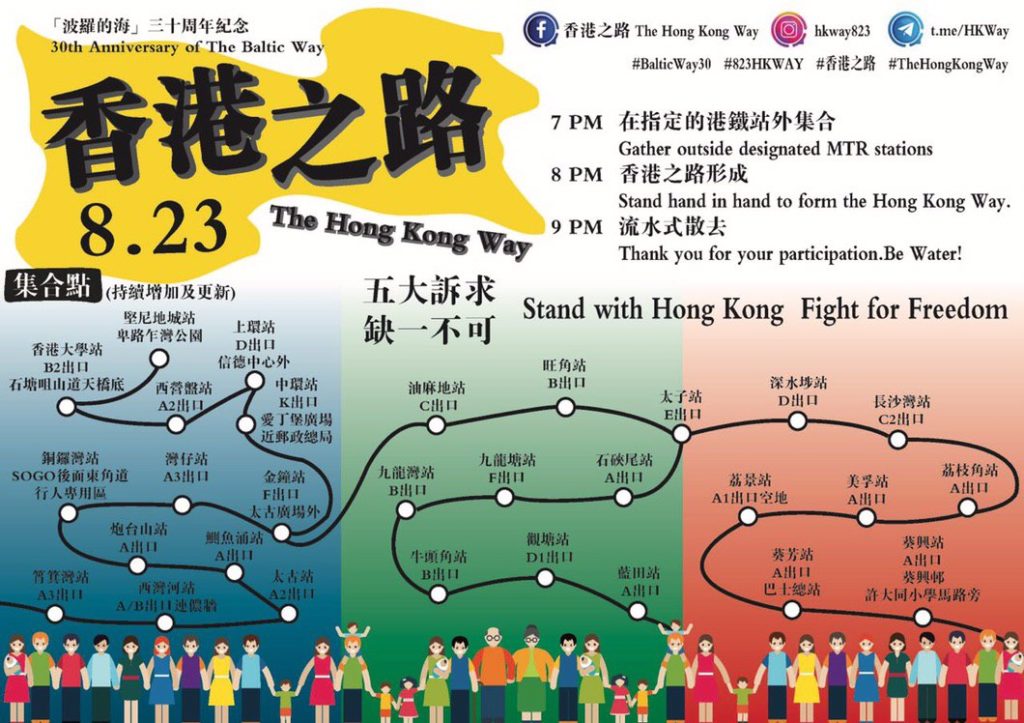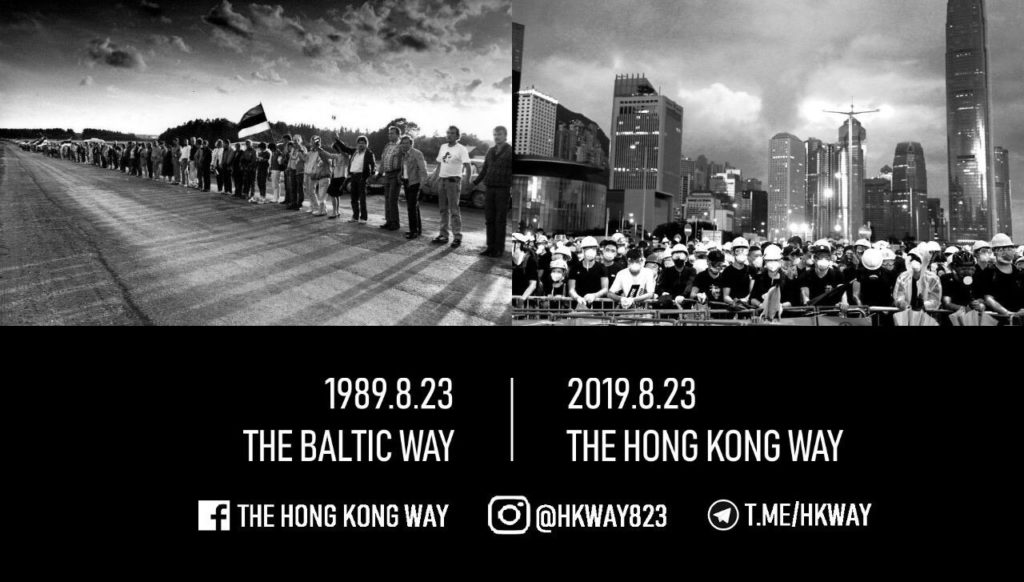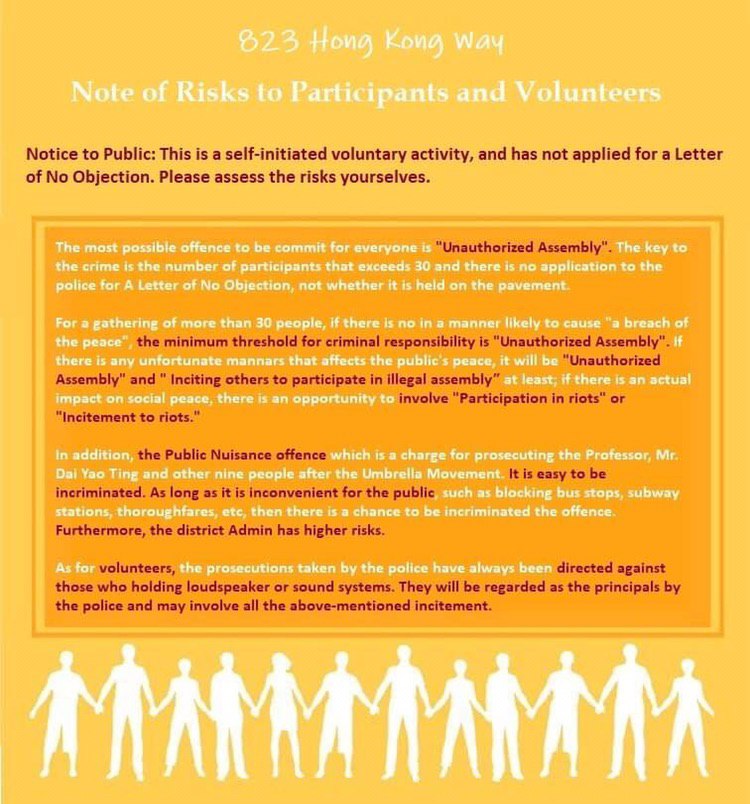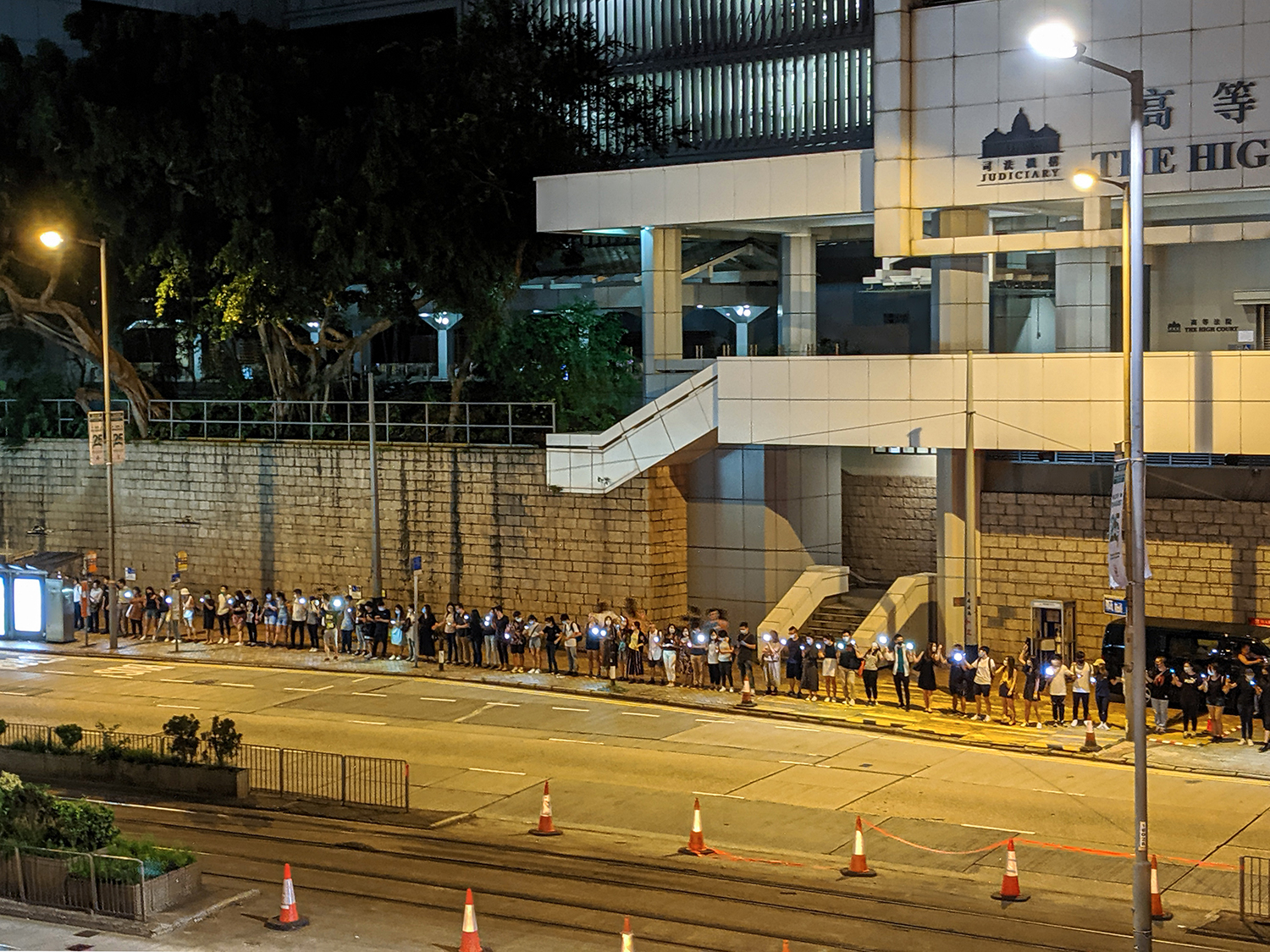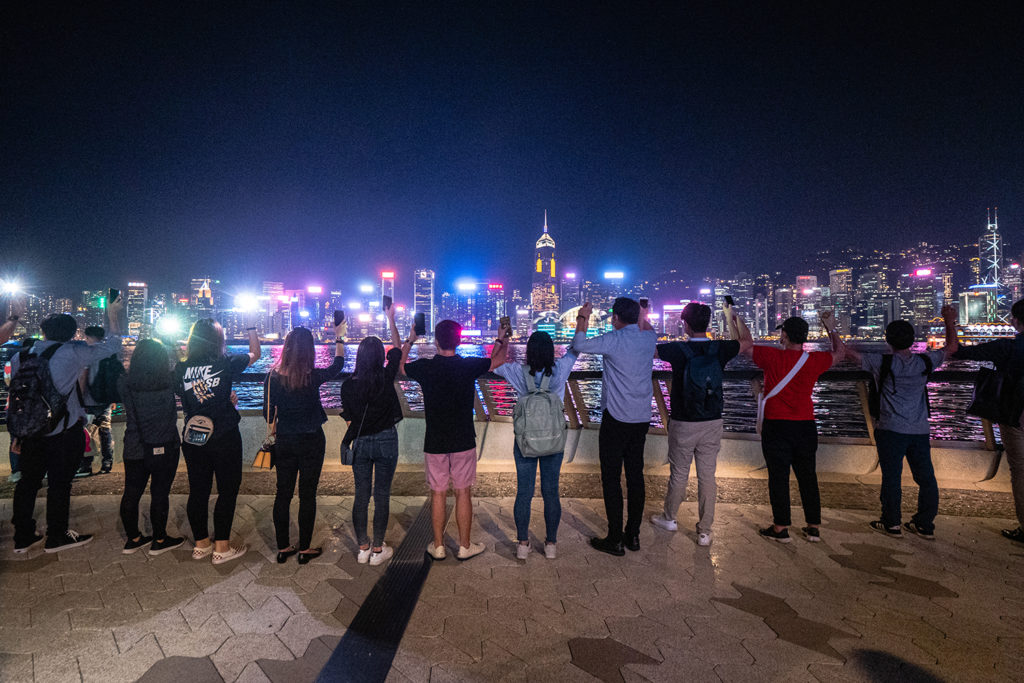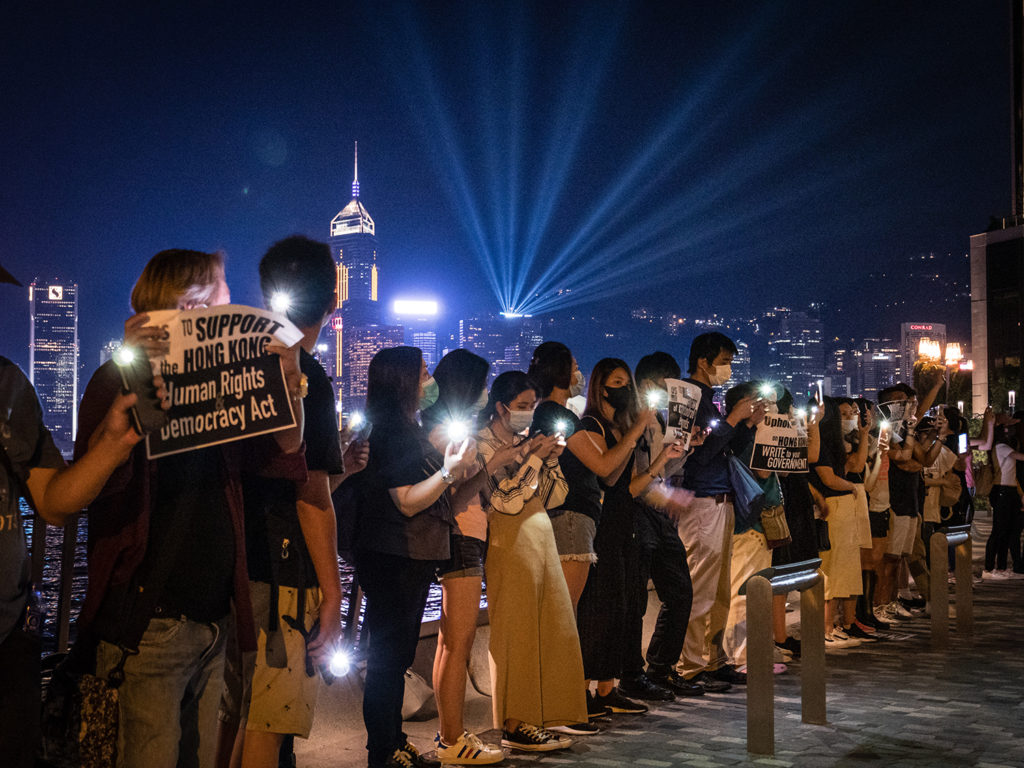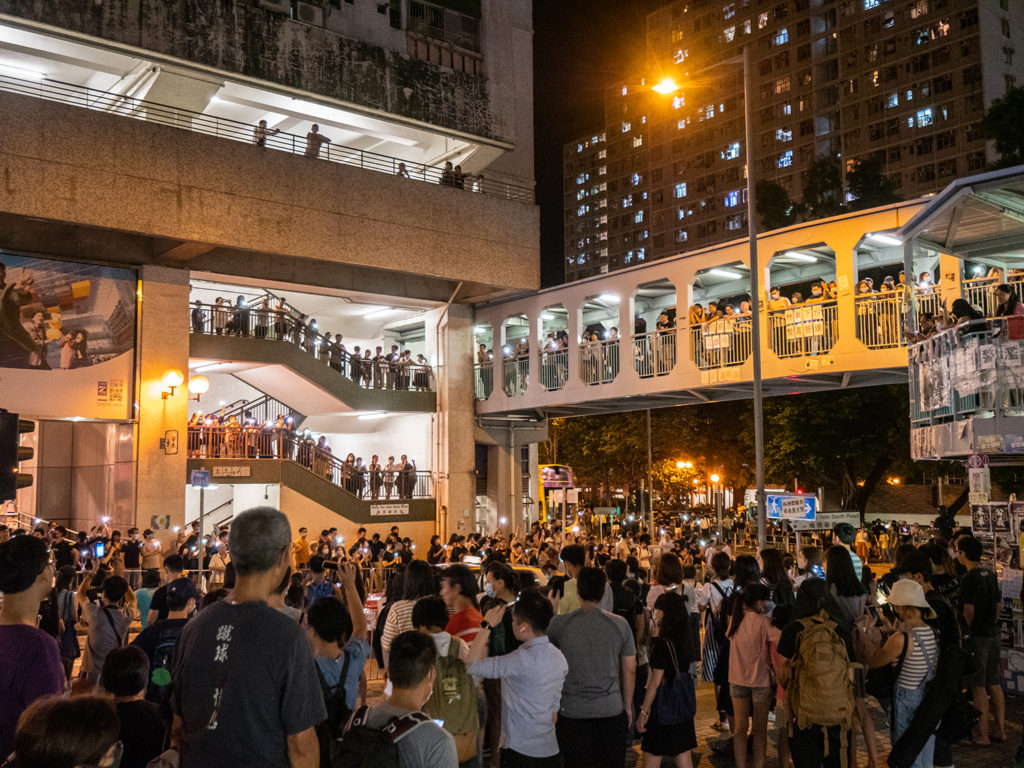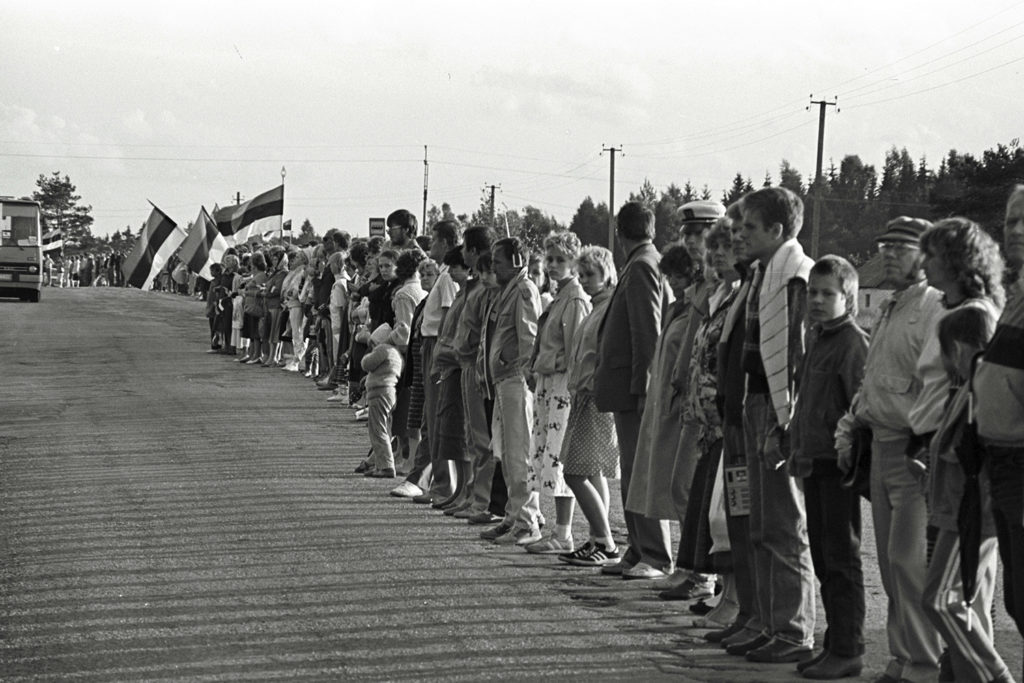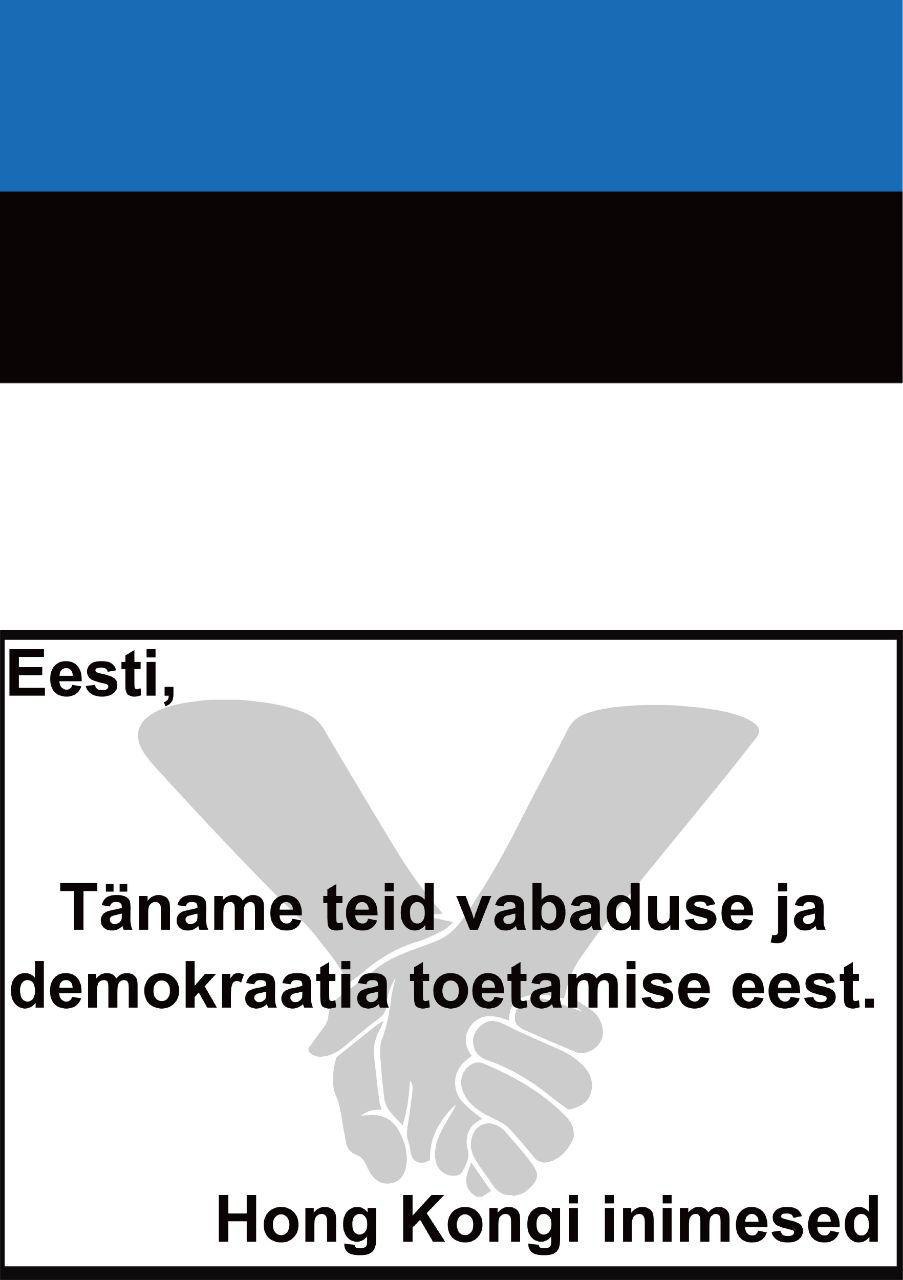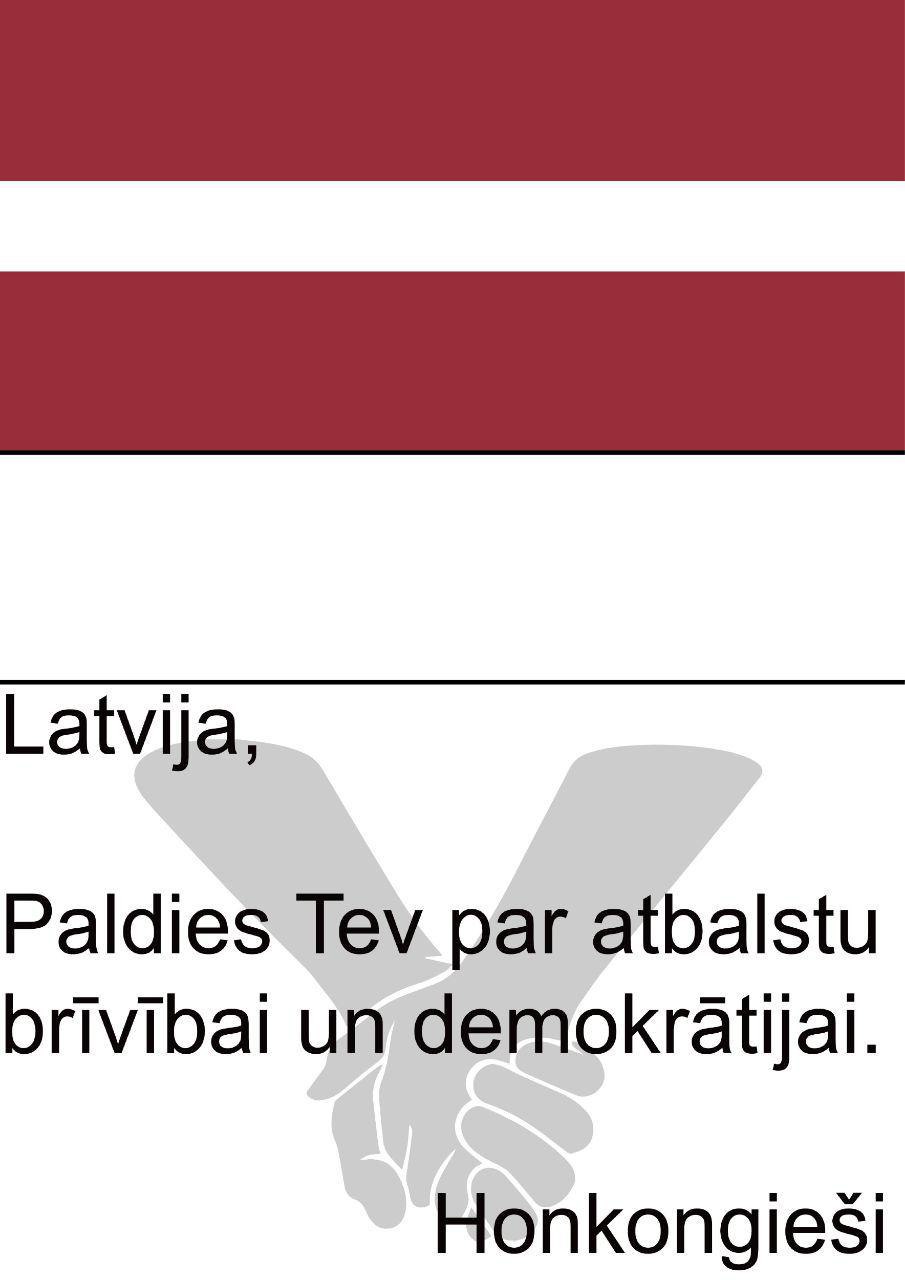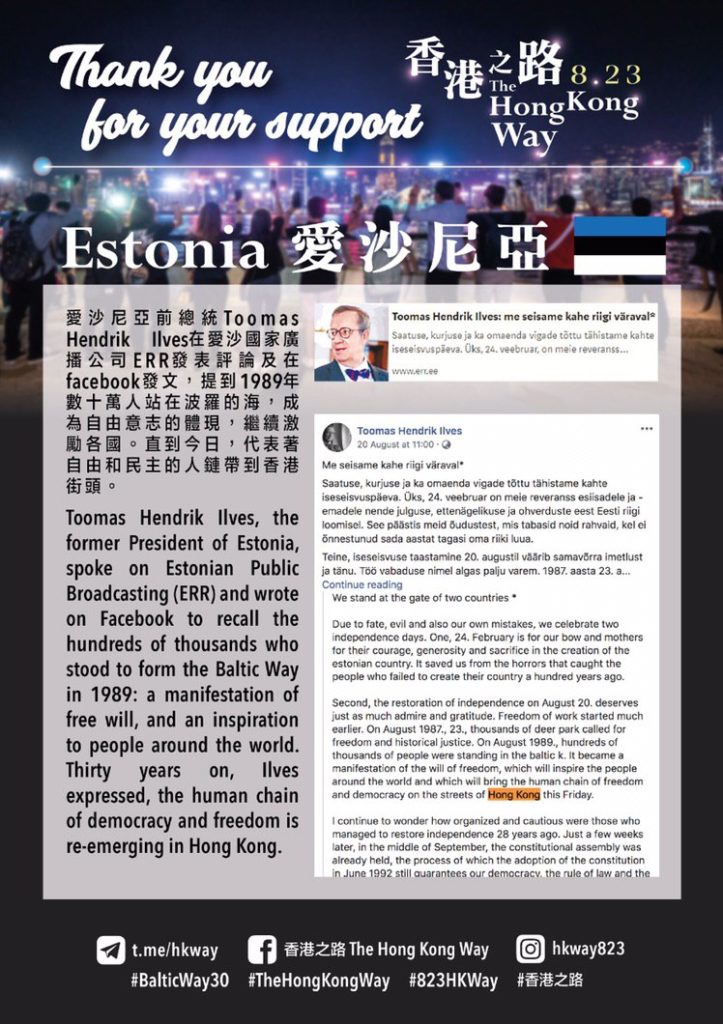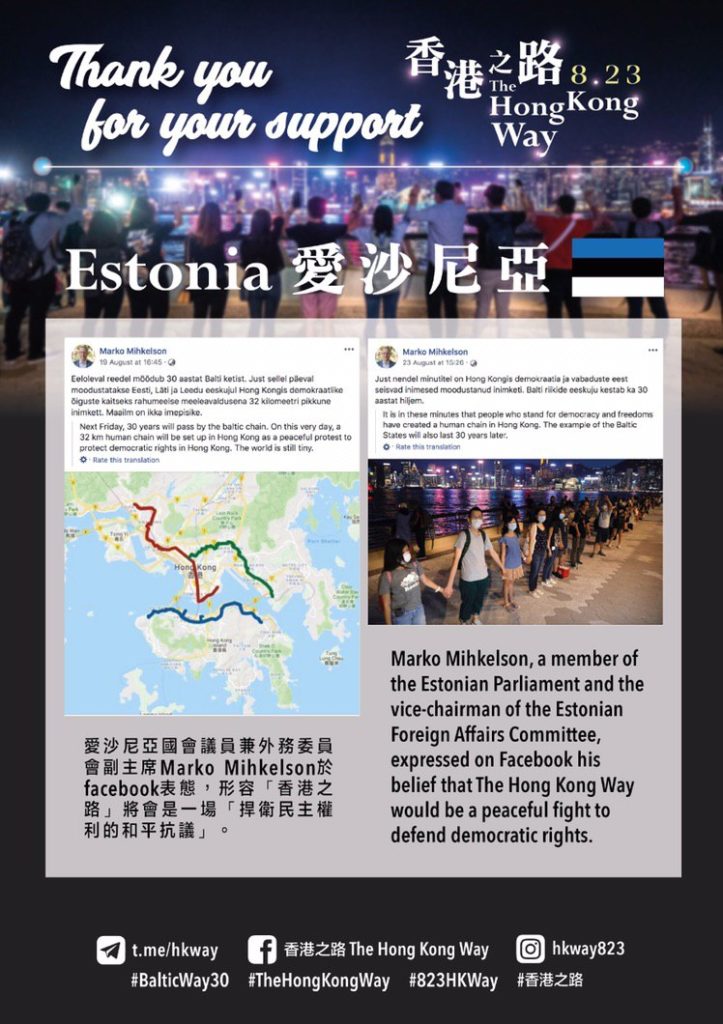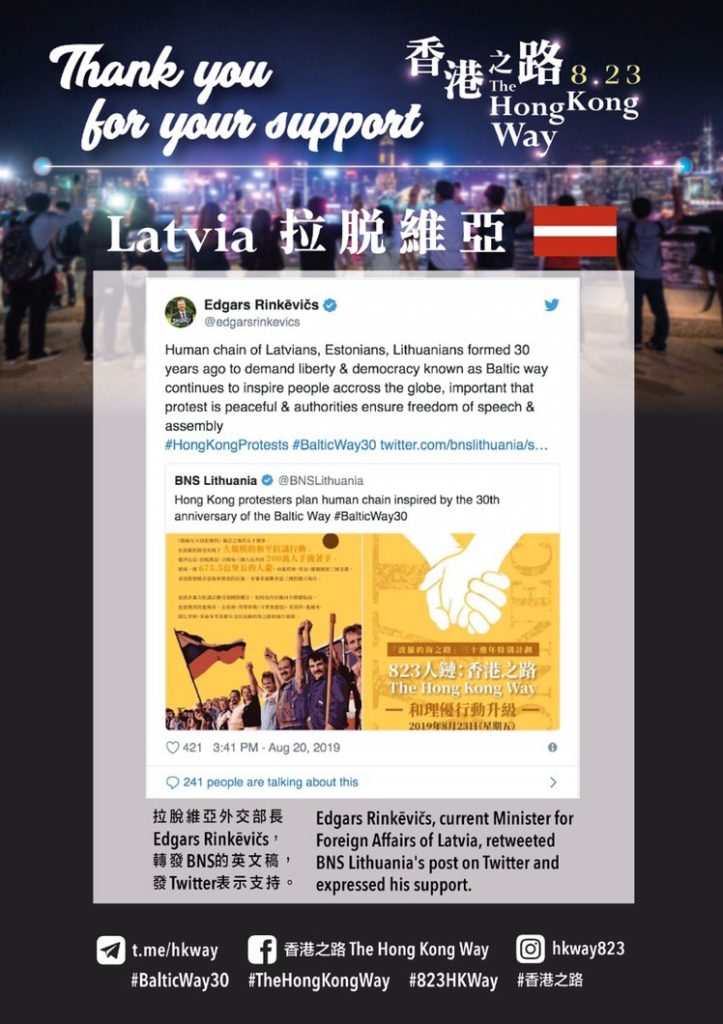Chains of Freedom:
the Baltic Way's legacy in Hong Kong
Similarly to the Estonians, who were forced to endure totalitarian dictatorship, imposed upon them by the Soviet occupation that began in 1940, Hongkongers have been forced to endure Beijing-backed authoritarian rule since the handover of Hong Kong from the United Kingdom to the People’s Republic of China in 1997. During the Soviet occupation, Estonians used several innovative strategies to draw the democratic world’s attention to their struggle against the dictatorship. An Estonia-based Hongkonger noticed the adaptability of the Estonians’, Latvians’ and Lithuanians’ idea of the Baltic Way, and proposed an idea to organise a similar demonstration on the Hongkongese online forum LIHKG in August 2019. Less than a month after the proposal, 60 km human chain was organised with the participation of more than 210,000 Hong Kong residents. For protesters, the Hong Kong Way was a chance to demonstrate their determination to defend human rights, justice and rule of law.
The aim of the Hong Kong Way was to express dissatisfaction towards the Beijing backed Hong Kong government and present their five demands:
(1) the formal withdrawal of a draft bill which would allow the extradition of Hongkongers to mainland Chinese courts;
(2) establishing an independent Commission of Inquiry to examine excessive use of force by the Hong Kong police during the 2019 Hong Kong protests,
(3) retraction of the characterization of the 2019 Hong Kong protests as ‘riots’,
(4) granting amnesty to the arrested Hong Kong protesters,
(5) introduction of universal suffrage for the elections of Chief Executive, the city’s head of government and its Legislative Council (a de facto parliament).
Inspired by the Baltic Way
The idea of forming a human chain in Hong Kong came from the Tallinn-based Hongkonger, who was inspired by the 1989 Baltic Way. On 23 August 1989, about two million Estonians, Latvians and Lithuanians formed a 600 km human chain stretching from Tallinn to Vilnius. The aim of the demonstration was to draw international attention to the 50th anniversary of a non-aggression treaty (so-called Hitler-Stalin or Molotov-Ribbentrop Pact), signed between Nazi Germany and Soviet Union. In the secret annex of this pact, Stalin and Hitler decided their spheres of influence in Eastern Europe. The treaty enabled Germany to attack Poland in 1939. The Soviet Union got a free hand to illegally occupy the Baltic States less than a year later. The Baltic Way took place in a different historical context than the Hong Kong Way. Both are linked by the fact that the peoples that participated in the human chain did not have the freedom to decide their future at the time. It was Nazi Germany and the USSR who decided the fate of Estonians, Latvians and Lithuanians in 1939. It was the United Kingdom and China who determined the future of Hongkongers without the presence of a Hong Kong representative during the negotiations in 1984.
The map of the Hong Kong Way which encompasses all parts of Hong Kong – the New Territories, Kowloon Peninsula and Hong Kong Island. The participants formed a human chain through metro stations, ferry piers and the iconic Lion Rock Mountain.
The planned metro routes of the Hong Kong Way before the human chains were formed . Written in Cantonese, the leaflet called for the fulfillment of Hongkongers’ five demands.
The promotional material emphasizes the significance of the 2019 Hong Kong Way as a commemoration of the 1989 Baltic Way, symbolizing how Hongkongers fight for freedom and democracy similarly to the peoples of the Baltic States.
The left side of the leaflet shows a segment of the Baltic Way featuring an Estonian flag. The right side of the leaflet shows a group of Hongkongers gathering in front of the Legislative Complex (the location of Hong Kong’s de-facto parliament) in the presence of the police.
Reminder to the Hong Kong Way participants regarding the potential risk of being arrested by the police. The leaflet listed possible criminal charges for taking part in a peaceful human chain in Hong Kong.
Police violence
In March 2019, the Hong Kong government, controlled by the Chinese central government, proposed a bill that would have enabled extradition of Hong Kong residents to the courts of mainland China, where it is not possible get a fair trial as they are controlled by the Chinese Communist Party. The bill was made public, which resulted in wide-spread protests that lasted six months. The police used disproportionately harsh measures against the protesters that violated human rights. International organisations’ official evidence shows that the Hong Kong police unlawfully used batons and rubber bullets, tear gas, pepper spray and live ammunition. Medics and journalists were obstructed from doing their job. On 11th August, a police officer shot a bean-bag round into a paramedic’s eye during a scuffle between protesters and police, rupturing her eyeball. The Hong Kong Way was also a peaceful response to earlier police brutality. Some participants of the Hong Kong Way covered their eye to show solidarity – the gesture had become a symbol of protest against police violence.
The human chain covered the High Court of Hong Kong in Admiralty, Hong Kong Island. It was one of the main protest sites during the 6-month anti-extradition protests in 2019.
Some participants of the human chain covered their eyes to remind the public about a medic, whose right eyeball was ruptured as the riot police shot a bean-bag round to her eye during a scuffle between the protesters and police.
The participants near the Victoria Harbor in Kowloon Peninsula waved their mobile phone torch light to make the human chain visible from a distance.
The participants near the Victoria Harbor in Kowloon Peninsula raised leaflets to call on the US government to support Hong Kong by implementing the Hong Kong Human Rights and Democracy Act of 2019.
Hong Kong Way and the Baltic Way
Compared to the 1989 Baltic Way, organizing the 2019 Hong Kong Way proved to be more challenging due to the leaderless nature of the protests and the geography of Hong Kong. The Baltic Way was organized by the political leaders of the Baltic states’ independence movements. The Hong Kong Way was organized by several groups using Telegram, an encrypted instant messaging application. Plans were discussed on the Cantonese online forum LIHKG. Forming a continuous human chain between the Kowloon Peninsula and Hong Kong Island was impossible, as Victoria Harbour separates Hong Kong Island from the rest of the territories. Yet, Hongkongers managed to link both parts of Hong Kong by connecting the human chain on a ferry.
A volunteer leading the human chain on a green pedestrian light to avoid blocking the traffic.
Hundreds of Hong Kong Way participants formed an irregular human chain in a public housing estate near Hong Kong Baptist University, a university which is located right next to the Chinese People’s Liberation Army Hong Kong Garrison.
Dozens of Hong Kong Way participants climbed up to the 495 metre tall Lion Rock Mountain and lit up the mountain with a laser pointer.
Participants in the Baltic Way. On 23 August 1989, the Baltic nations attracted international attention with the Baltic Chain – a human chain that stretched from Tallinn to Vilnius and focused attention on the injustice of the half-century-long Soviet occupation and the tens of thousands of victims.
Hong Kong Way leaflets and thank you notes
Prior to the organization of the Hong Kong Way, Hongkongers initiated a crowdfunded global campaign to call for international support for Hong Kong. The advertisements were published in 11 newspapers in ten countries, including the US, Canada, Japan, South Korea, Spain, Germany, Taiwan, France, Sweden and Denmark. The aim was to draw further attention to the situation in Hong Kong. The organizers of the Hong Kong Way called the protesters of 14 countries to support Hong Kong with slogans translated into the respective languages of these countries. The choice of countries was determined by the number of local activists interested in the topic as well as the local Hongkongese community, who were prepared to contribute their time and money.
In addition to highlighting the connections between the Baltic Way and Hong Kong Way, screenshots of online comments from the Baltic States’ politicians became part of the promotional materials for the Hong Kong Way.
